Eat This While You Read That: Michael Z Williamson
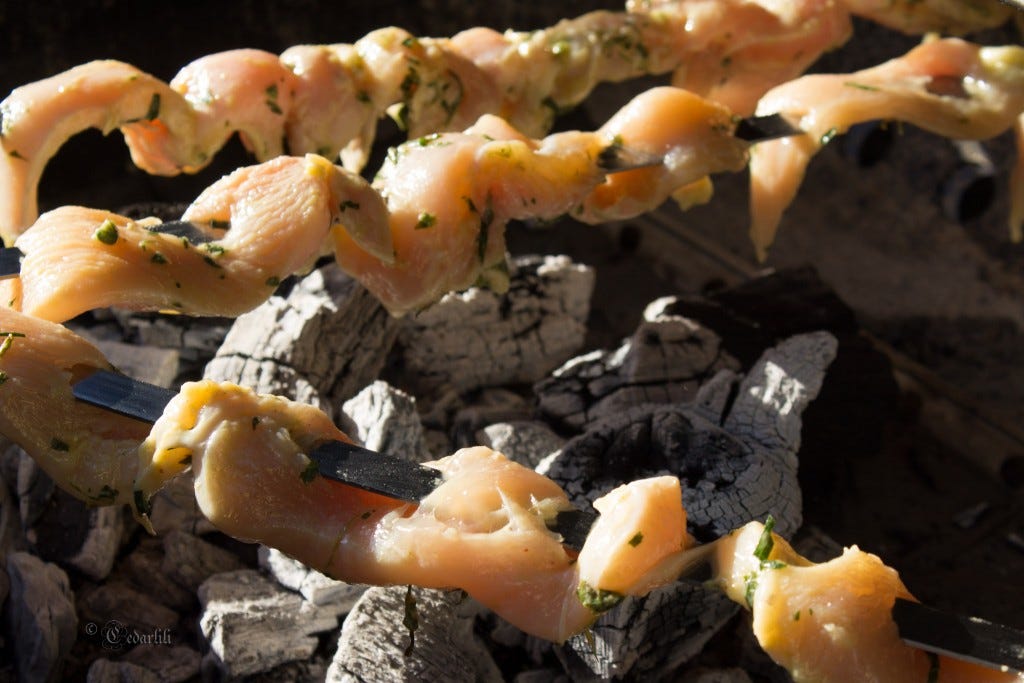
Cooking over the coals on bayonets (not really, but it's fun to pretend)
This week's ETWYRT is a little different. It was, for one thing, a meal that had me doing much more contemplation than usual before I embarked on it. When I asked MadMike for a dish, I knew he was busy and wouldn't send a recipe, except... he did. And an unspoken challenge. He knows me well enough to know I was capable of doing it, but I wanted to do it right, so I took my time and thought it through before starting.

I absolutely love the cover art on this one.
You see, Mike's latest book, A Long Time Till Now, is a departure from his previous work. It's a hard science fiction novel about a military unit which slides into a different time - the Paleolithic, to be precise. They must survive using only what they have on hand (very little) and their wits. In preparation for the book, Mike spent a lot of time on research, with much hands-on research into tools, diet, and more. This is what he challenged me with - cooking a meal which would fit into that framework.
I immediately hit a snag. Well, two of them. One was time. While I know my way around cooking over an open fire, and foraging wild edibles, this summer has been chock-full of weddings and activities and... argh. The second snag was space. We have a little back yard and no way of building an open fire. So I compromised. Rather than sticking to foods from the Paleolithic, I went with gathering wild edibles and cooking over a fire built in my little grill. Constrained, but fitting into the challenge.
In the article Mike sent me where he lays out his research, is a recipe for stone age chicken, so I chose to cook chicken with a side of chicory and sauteed mushrooms with tubers.
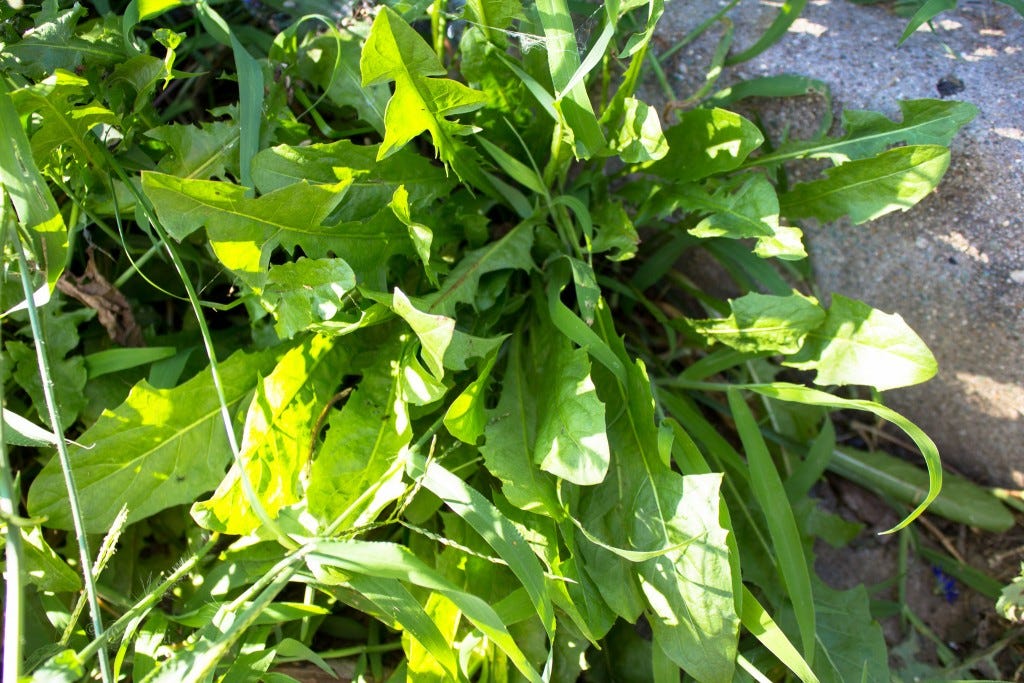
Chicory grows profusely in my yard. You want to collect the rosette of leaves from a plant that has not yet bloomed, and they closely resemble dandelion which can be cooked in the same way.
Chicory (Cichorium intybus) and Dandelion can be prepared in much the same way, and indeed, are cultivated and eaten in Europe, where they originate. It is a rather bitter herb, although if harvested in very early spring can be eaten in a salad. Since it was nearly August when I prepared it, I chose to make it as a potherb, although this is not my preference for eating greens. However, it was once very common cooking method, for various reasons, and now that we know it kills germs, I can't argue too much with my long-gone foremothers.
Once you have enough chicory (and it won't be enough, because boy does this stuff cook down) then you will want to rinse it thoroughly. I found a lovely big spider while I was cleaning my greens... Also, this lets you pull out any mingled grass or leaves you cut along with the rosette. I chopped my chicory leaves into roughly 1" lengths and put them in boiling water for a few moments. This removes much of the bitterness, and you can drain and discard the cooking water before the next step, leaving the leaves in the colander to drain thoroughly.
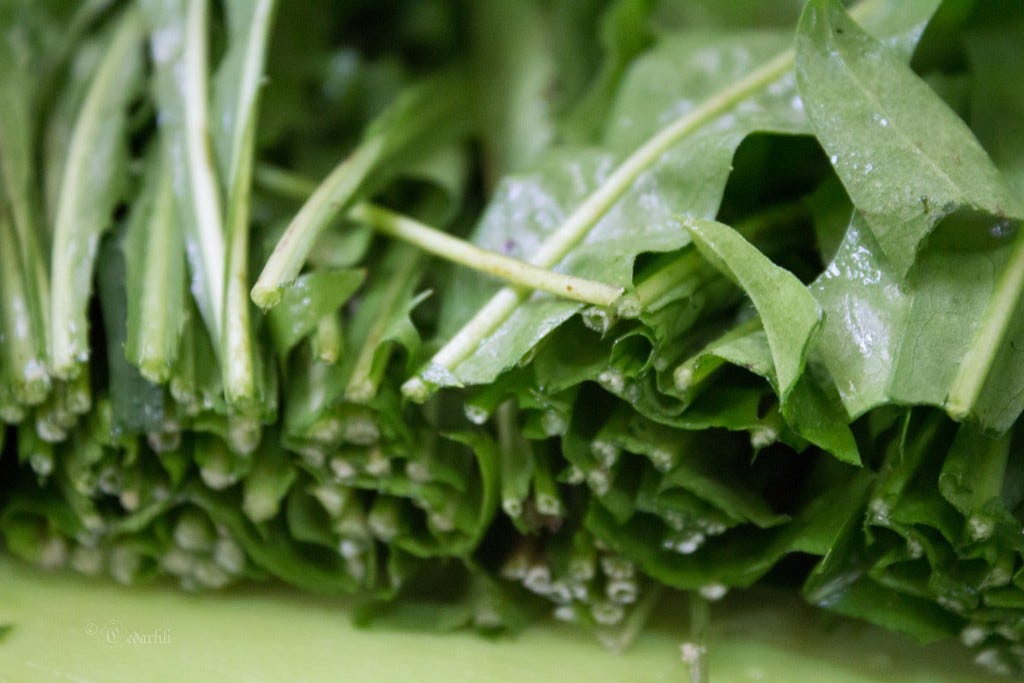
You can see the milky sap oozing from thhe cut stem-ends. Any plant with milky sap will be bitter, as it likely contains latex.
As you drain the chicory, put fat in the bottom of your pan to heat. I used bacon grease, but if you were truly foraging, the leaf fat found around the kidneys of a rabbit or other animal would work nicely for this purpose. Oils and fats are vital to life and diet when living a very active lifestyle as the foragers would have done in his book. While we may abstain in a modern diet, doing that in a survival situation could kill you.
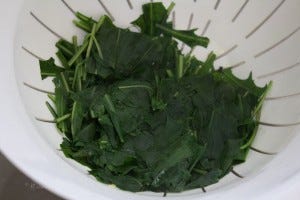
The drained chicory, and you can see how little there is left.
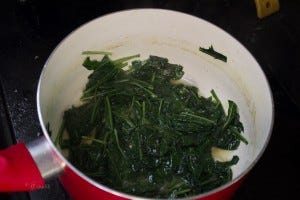
Fried chicory greens, rather greasy, but that's a good thing.
Fry the chicory in the grease, with a little salt, and vinegar if you have it. Really, this came out well, but I omitted the acid and it would have been better with that.
While you are doing this, heat a cast-iron skillet (in the book, they would have made do with stones, I suppose, or a small metal pot. Once upon a time soldiers carried canteen cups which would be handy, but I suspect those are no longer part of the kit). In the skillet, more fat, then slices of tuber (potato, but jerusalem artichoke, ground nut, or yams would all have worked in a forage situation) and mushrooms.
I'll pause here to mention that collecting and eating wild mushrooms is an endeavour fraught with perils. There are many, many kinds of fungus, and few are edible. Of those that are edible, some can sicken one person, and not another. I used Oyster Mushrooms in this dish, and a close relative to them, Angel Wings, can damage the kidneys of certain people who are genetically susceptible to them. In other words, you would never know, you'd just get sick. Inky Caps, another delectable wild fungus, cannot be eaten in conjunction with alcohol or it will poison you. I cannot stress enough how important it is to be certain of your identification of wild mushrooms before you ingest - or even handle - them.

A mess of wild onion, tuber, and mushrooms.
For the chicken, I chose to cook over hardwood lump charcoal on skewers. Cooking over stones is fine, but the only ones I have available are river rocks and those can be dangerously explosive when heated. Also, skewers can be had from most trees and bushes. In general, you want to avoid making them from any conifer or evergreen, and cherry trees. But willow is a common creekbed denizen, and maple is perfectly fine... Cut and use green skewers, so they don't burn over the fire and drop your meat on the coals. Ashes are not good eats.

Herb, lemon, and oil marinade
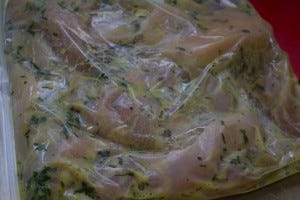
Marinading the chicken for more flavor. Can also be done in a covered bowl.
Take your chicken and break it down into strips of meat (I was using chicken breast, so that was easy. Foragers would use the whole thing and likely not bother deboning). I made a marinade for the chicken to infuse it with more flavor. This would be possible even in a forage setting, if your forager has access to acid (lemon juice, vinegar, etc.) and oils. I put lemon juice, olive oil, a dollop of stone-ground mustard (a common weed which can readily be harvested for the leaves and seeds to add a lot of flavor), and handfuls of herbs which mimic the flavors of wild herbs, as given below. I also added a dollop of fish sauce. Garum, the distant (squint and you can see the relationship) progenitor of our modern Asian condiment, was an ancient condiment, salt-substitute, and exported over the known world. So fish sauce in an ancient dish would not have been too outre.
Tarragon= wild carrot leaves (Queen Anne's Lace)
Oregano and peppermint = wild mint
Thyme = wild thyme (quite common in Europe and western Asia where the book is set)
Now, for authenticity you would grind all this in a mortar with pestle, but I used my blender (Time! So little time and foraging can take all day to prepare a big meal). You can marinade as I did in a ziploc bag, or you can do so in a covered bowl. I left it for thirty minutes while I was beginning the other preparation.
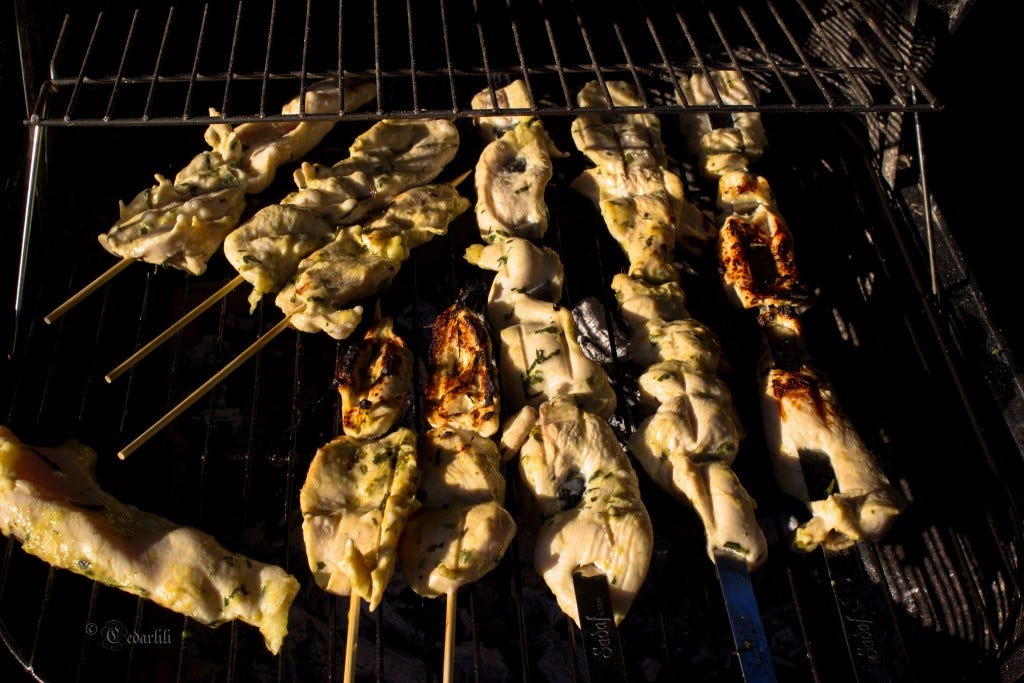
I cheated with the grill, having made too much chicken (but leftovers were good!).
If you are in a forage situation, your fire is likely already going, small, almost smokeless, and a tight mound of hot coals in a ring of rocks. I used the hardwood charcoal in a grill. Keep in mind you do not need visible flames - indeed, they are most undesirable - when you are cooking over an open fire. Coals give a more even, reliable heat.
Thread the strips of chicken onto the skewers and place over the fire. You do not want them too close to the coals, and you don't want them to fall into the fire, so keep an eye on them. Turn them a quarter-turn every five minutes, until they are cooked through (about 20-30 minutes) and golden brown in places.
Serve with the chicory and fry-up. I sprinkled allium flowers over the plates before serving, because I could. Also, yummy garnish.
This made a delicious meal. The chicory served under the chicken made a lovely green bed and was very tasty. The chicken was lemony, herby, and very close to souvlaki in flavor profile although I hadn't intentionally engineered that. We all ate our fill and there was leftover chicken which went in the freezer for another day. A very repeatable meal, and although I made a lot of short-cuts, this is entirely conceivable as a foraged meal, with the exception of the chicken. We live too much in town for me to come up with a wild creature as the center of a meal, and I think the First Reader would draw the line at the plump gray squirrel which raids my birdfeeder.
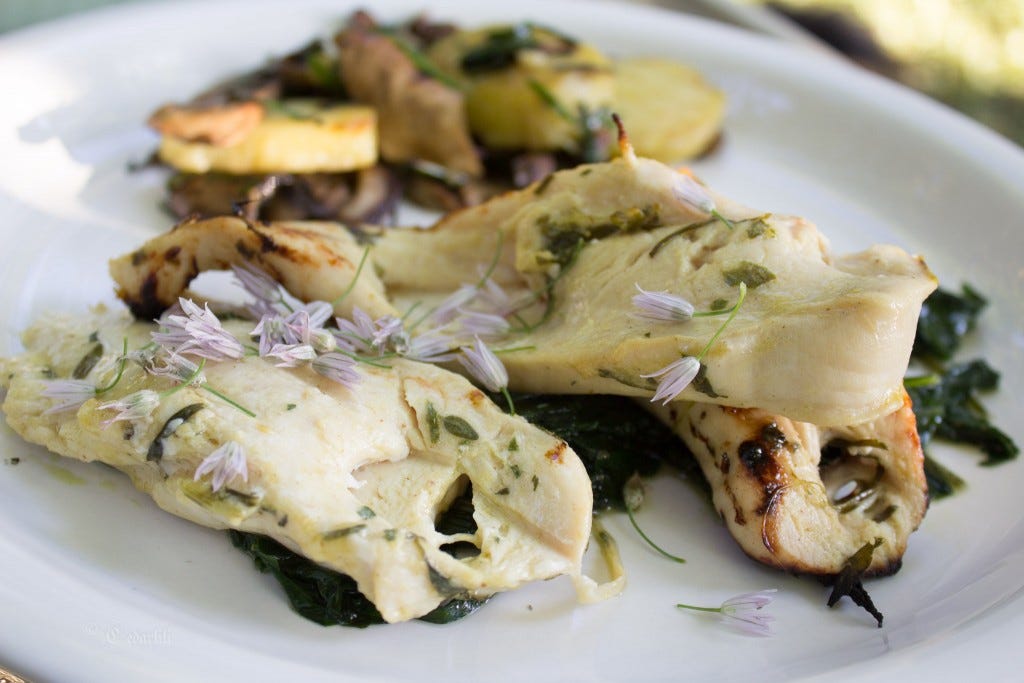
The finished forage meal. Surprisingly beautiful for what it is, no?




